 10 German Hilfskreuzer (1937-40): Orion, Atlantis, Widder, Thor, Pinguin, Stier, Komet, Kormoran, Michel
10 German Hilfskreuzer (1937-40): Orion, Atlantis, Widder, Thor, Pinguin, Stier, Komet, Kormoran, Michel
Historical Overview
Privateers freighters are already a very old idea: Since the Renaissance and seventeenth or eighteenth centuries, merchant ships were armed, but with a reduced artillery. One could still make a difference. But from the nineteenth century, all hulls were painted with rows of false gun ports, and this according to a stylistic tradition continued until the twentieth century.
The principle was to deter potential “predators”. During the Secession war already, the Confederate Navy largely outclassed, used armed civilian ships as commerce raiders and blockade runners, while already the young American navy used fast bricks and armed merchant clippers to attack British vessels in 1815. Some corsairs also started to use various disguises to hide their armament, unveiled only at the last moment.
German Raiders in ww1
During the Great War, Germany employed several ways to disrupt British trade and counter the Blockade, using a number of privateers: The Möwe, Wolf, Greif, Wolf II, Geier, Leopard, Iltis, and Seeadler (a tall ship). Using such kind of ship was singular but not anachronistic: Nearly half of the merchant tonnage in 1914 was still assumed by sailing ships. These ships enjoyed mixed success, had artillery up to 105 and 150 mm, light guns and torpedo tubes. Guns were hidden under the hinged folding panels for quick release. The Hochseeflotte also commissioned a number of fast ships as auxiliary cruisers: Steamer SS Kaiser Wilhelm der Grosse, Prinz Eitel Friedrich, Crown Prince Wilhelm, and Kormoran, Cape Trafalgar, Berlin, Vineta and Meteor.
German Auxiliary Cruisers in Action
Their process was intangible: When a raider spotted a merchant ship, the former was closing up to be at firing range, compared the name of the ship to Lloyd’s register to identify her as Belligerent or neutral. By megaphone, the raider’s captain then intimated his fellow counterpart to stop, while unveiling its artillery and true flag. The cargo was then torpedoed or gunned into oblivion after been warned to evacuate, leaving a chance to the crew. Neutrals were visited by a company that checked the bulk list.
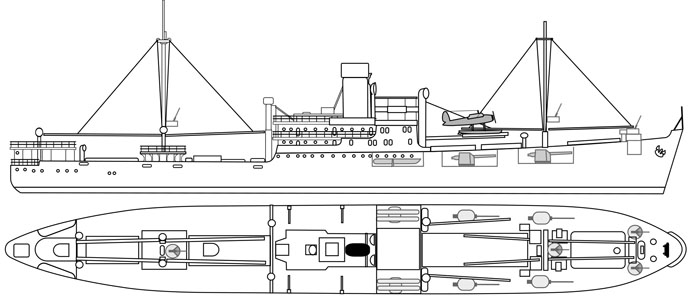
Blueprint of the Komet
If it was bound for neutral ports, the cargo could resume its journey unmolested, otherwise the process was repeated, crew evacuated and the ship sunk. Eventually raiders also sometimes attacked military vessels. Disguised as a cargo and flying neutral flags and markings or the silhouette of another ship through improvised contraptions. The captain waited until the military ship was close enough to launch an inspection party and unveiled at the last moment its true colours while revealing its artillery hidden behind folding panels, and opening fire asap, even also sometimes launching a torpedo without warning. What generally followed was a short and bloody artillery duel at close range for which the Raider had the advantage of surprise.
German Raiders in 1939
In 1939, facing a lack of ships to launch an effective commerce war, the concept was reactivated with new ships converted, even more heavily armed than in teh first world war. The “Hilfskreuzer” (auxiliary cruisers, generally complemented by “HSK”- Handels Stör Kreuzer, commerce raiders) were one of the trump cards of Admiral Raeder in his strategy. They ships were generally recent, powerful and fast, roomy and adaptable (and equipped) to fake numerous identities. Their armament was obsolete (old cannons salvaged from cruisers of the Hochseeflotte), but their crews were hand-picked and the best in the German Navy. However the results of their campaign was relatively disappointing. One the right are some of these Ships and their stories.
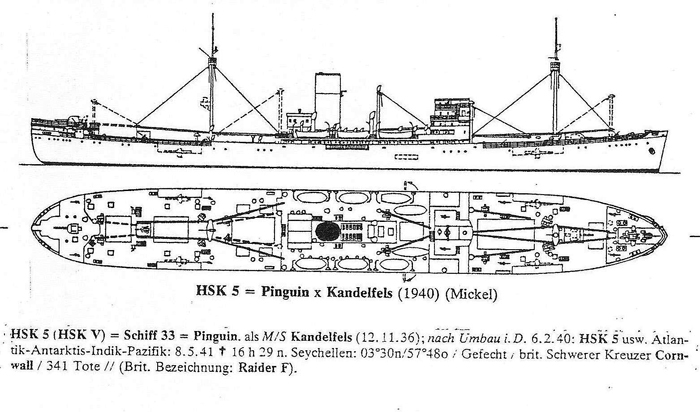
Blueprint of the Pinguin, same class as the Atlantis
Just as during the First World War, the German navy turned for use as auxiliary cruisers a number of recent, massive and fast freighters. The changes, made through civilian authorities with civilian engineers and military equipment were sometimes radical, and the vessels in question, apart from speed, had real offensive capabilities, threatening even for cruisers. The aim of the design was to have them mimicking a large array of near-similar or approaching neutral ships, approach other ships, then reveal their true identity.
Such procedure did not include capture but annihilation of the opposing ship, often after allowing the crew to evacuate, by means of 150 mm reformed guns and torpedo tubes. They could also laid mines unsuspected, or repel strafing attacks by their AA artillery, all served by modern fire control systems. For long range reconnaissance they embarked one of two seaplane. Small torpedo crafts tailored to operate also from the ship were another way to deal with protected harbours, extend her reach or catch faster ships.
The results they obtained in operations were generally good. 9 ships (HK1 to HK9) were put into service, keeping their civilian name: Orion, Atlantis, Widder, Thor, Pinguin, Stier, Komet, Kormoran and Michel. Their most active and effective period was 1939-1941: Together they sank 140 ships, a total of 700 000 tons. A score well above other military ships of the Kriegsmarine, and also superior to many U-Bootes. They were feared by allied crews, but in general their captains behaved according to the natural unwritten solidarity rules of sailors at sea. When not gathered to be kept on board, crews of sunk ships were often given food, blankets, navigation instruments or maps and directions.
KMS Orion
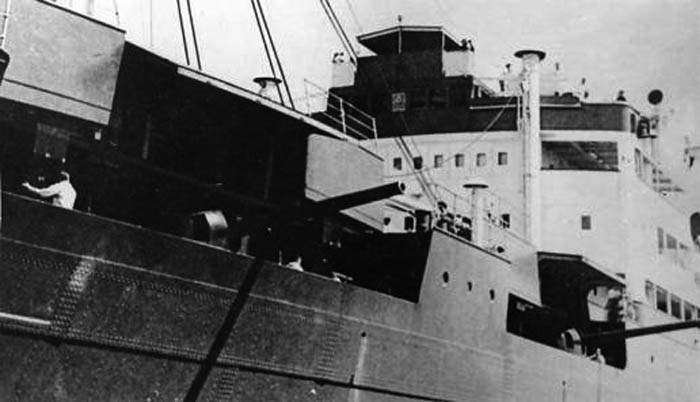
KMS Orion in 1940 (bismarck-class.dk)
Launched in 1931 in Hamburg, former SS Kurmark. Requisitioned, armed, equipped and put into service in December 1939. Covers: Dutch Beemsterdjik, Soviet SS Sovet, Japanese Maebasi Maru. Sank 5 ships (41 138 GRT), participated in the destruction of 4 others. Became the gunners training ship Hector in January 1944, then cadet training ship Orion in 1945. Sunk by RAF in Swinemünde April 4, 1945.
Specifications |
|
| Dimensions | 148 x 18,60 x 8,20m |
| Tonnage (Empty/Fully Loaded) | 15 700 tons (7021 GT) |
| Crew | 351 |
| Propulsion | 1 screw, Blohm & Voss turbine, 4 boilers, 6200 hp = 13,5 kn |
| Armament | 6 x 150mm, 1 x 75mm, 4 x 37mm AA, 4 x 20mm AA, 6 TT 533 mm, 288 mines, 2 planes |
KMS Kormoran
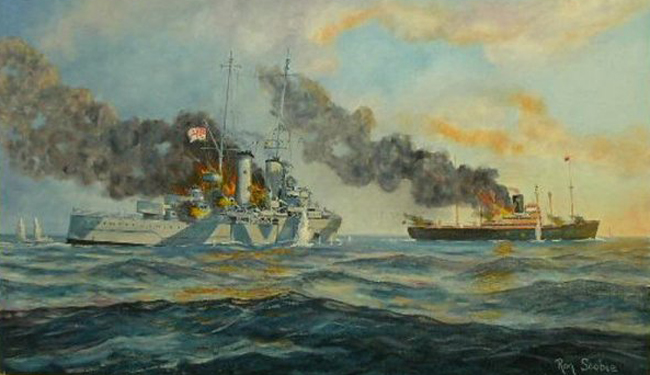
Battle between HMAS Sydney and Kormoran
Probably the most famous German Hilfskreuzer, and corsair of the Second World War. Formerly the bulk carrier Steiermark, it was rebuilt in Kiel in 1938-39, and completed in 1940 under the name of Schiff 41, and a profile resembling Viacheslev Molotov and Japanese Satiko and Kinka Maru (above). She could also quickly be converted in many other disguised. British secret service “Raider-G.” Like any of its kinds, she wore a heavy armament, hidden 150 mm pieces and AA artillery in dismantled parts easy to reassemble very quickly. Two banks of torpedo tubes were hidden in the sides, above the waterline, but the other two were submarine. No radar was provided so she carried Arado 196 for advanced long range recognition, and a single torpedo craft LS3, able to launch two aviation torpedoes. Her cruise in the Pacific lasted 350 days, during which she sank or captured 11 ships, to be eventually tracked down and sunk by the Australian cruiser Sydney (also lost), following a bloody close quarter duel.
Specifications |
|
| Dimensions | 164 x 20,20 x 8,50m |
| Tonnage (Empty/Fully Loaded) | 19 900 tons, 8736t GRT |
| Crew | 400 |
| Propulsion | 2 screws, 4 diesels Kupp-Germaniawerft, 2 Siemens Schuckert motors, 16 000 hp, 18 kn |
| Armament | 6 x 150mm, 1 x 75mm, 4 x 37AA, 5 x 20mm AA, 6 TT 533 mm, 360 mines, 1LS MBT, 2 planes |
KMS Atlantis

Profile of the Atlantis disguised as the Kasii Maru
Launched in 1938 in Bremen. Requisitioned, armed, equipped and returned into service in November 1939; Covers: Freighter MS Goldenfels, Norwegian Knute Nelson, Soviet freighter SS Kim, Japanese Kasii Maru, Dutch Abbekerk. Its 150 mm guns came from the battleship Schliesen. She had 2 Heinkel 114. Sank or captured 22 ships during her career (145 968 GRT), which classed her among the best German Hilfskreuzers. Ended in an unequal duel against the British heavy cruiser HMS Devonshire in the South Atlantic, November 23, 1941.
Specifications |
|
| Dimensions | 155 x18.70 x8.70 m ( ft) |
| Tonnage (Empty/Fully Loaded) | 17,600 tons (7862 GT) |
| Crew | 351 |
| Propulsion | 1 screw, 2 MAN diesels 6cyl, 7600 hp = 16 kn |
| Armament | 6 x 150, 1 x 75, 2 x 37AA, 4 x 20AA, 6 TT 533 mm, 92 mines, 2 planes |
KMS Widder

KMS Widder
Launched in 1930 in Kiel. Requisitioned, armed, equipped and put into service in September 1939. Also training ship Neumark. Covers: Norwegian SS Narvik, Spain’s Neptuno. Its 150 mm guns came from pre-dreadnought Deutschland. Had 2 Heinkel 114. Sank or captured 10 ships (58 644 GRT) in a 180-day cruise. Survived the war and became the British repair ship Ulysses. Returned to Germany, was used as training ship Fenchenheim. Ran aground on a sandbar near Bergen and was scrapped in situ in 1955.
Specifications |
|
| Dimensions | 152 x 18,20 x 8,30 m |
| Tonnage (Empty/Fully Loaded) | 16 800 tons (7851 GT) |
| Crew | 364 |
| Propulsion | 1 screw, Blohm & Voss turbine, 4 boilers, 6200 hp = 14 kn |
| Armament | 6x 150mm, 1x 75mm, 4x 37mm AA, 4x 20mm AA, 6 TT 533 mm, 2 planes |
KMS Thor
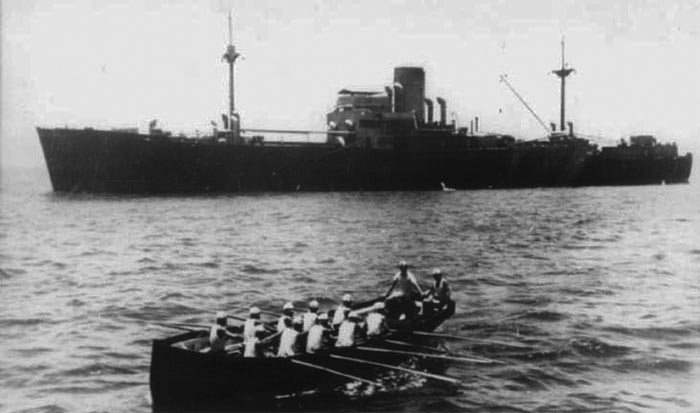
KMS Thor, South Atlantic 1940
Launched in 1939 in Hamburg as SS Santa Cruz. Requisitioned, armed, equipped and put into service in March 1940. Very fast for a cargo ship. Covers: Yugoslav SS Vir. Its 150 mm guns came from the old battleship Deutschland. Known by British intelligence as “Raider E”. Sank or captured 12 ships (96,541 GRT) in her first trip, 10 more in the second, totaling 55,587 GRT. Tied to the supply ship KMS Uckermark in Yokohama November 30, 1942 but exlosed for still unclear reasons. Declared total loss, scrapped in situ afterwards.
Specifications |
|
| Dimensions | 122 x 16,70 x 8,10 m |
| Tonnage (Empty/Fully Loaded) | 9200 tons (3862 GT) |
| Crew | 345 |
| Propulsion | 1 screw, AEG turbine, 2 boilers La Mont, 6500 hp = 18 kn |
| Armament | 6 x 150mm, 1 x 75mm, 1 x 37mm AA, 4 x 20mm AA, 6 TT 533 mm, 1 plane |
Links
Hilfskreuzer on bismarck-class.dk
Documentary duel HMAS Sydney vs Kormoran

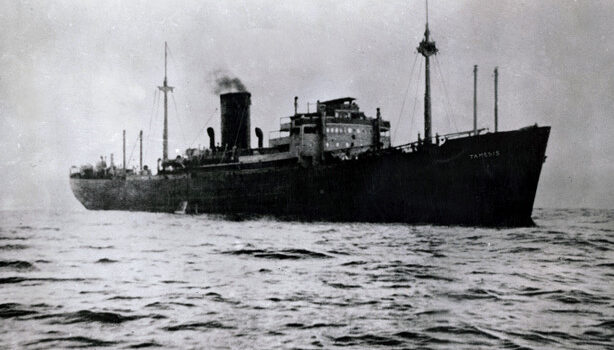
 Latest Facebook Entry -
Latest Facebook Entry -  X(Tweeter) Naval Encyclopedia's deck archive
X(Tweeter) Naval Encyclopedia's deck archive Instagram (@navalencyc)
Instagram (@navalencyc)





 French Navy
French Navy Royal Navy
Royal Navy Russian Navy
Russian Navy Armada Espanola
Armada Espanola Austrian Navy
Austrian Navy K.u.K. Kriegsmarine
K.u.K. Kriegsmarine Dansk Marine
Dansk Marine Nautiko Hellenon
Nautiko Hellenon Koninklije Marine 1870
Koninklije Marine 1870 Marinha do Brasil
Marinha do Brasil Osmanlı Donanması
Osmanlı Donanması Marina Do Peru
Marina Do Peru Marinha do Portugal
Marinha do Portugal Regia Marina 1870
Regia Marina 1870 Nihhon Kaigun 1870
Nihhon Kaigun 1870 Preußische Marine 1870
Preußische Marine 1870 Russkiy Flot 1870
Russkiy Flot 1870 Svenska marinen
Svenska marinen Søværnet
Søværnet Union Navy
Union Navy Confederate Navy
Confederate Navy Armada de Argentina
Armada de Argentina Imperial Chinese Navy
Imperial Chinese Navy Marinha do Portugal
Marinha do Portugal Mexico
Mexico Kaiserliche Marine
Kaiserliche Marine 1898 US Navy
1898 US Navy Sovietskiy Flot
Sovietskiy Flot Royal Canadian Navy
Royal Canadian Navy Royal Australian Navy
Royal Australian Navy RNZN Fleet
RNZN Fleet Chinese Navy 1937
Chinese Navy 1937 Kriegsmarine
Kriegsmarine Chilean Navy
Chilean Navy Danish Navy
Danish Navy Finnish Navy
Finnish Navy Hellenic Navy
Hellenic Navy Polish Navy
Polish Navy Romanian Navy
Romanian Navy Turkish Navy
Turkish Navy Royal Yugoslav Navy
Royal Yugoslav Navy Royal Thai Navy
Royal Thai Navy Minor Navies
Minor Navies Albania
Albania Austria
Austria Belgium
Belgium Columbia
Columbia Costa Rica
Costa Rica Cuba
Cuba Czechoslovakia
Czechoslovakia Dominican Republic
Dominican Republic Haiti
Haiti Hungary
Hungary Honduras
Honduras Estonia
Estonia Iceland
Iceland Eire
Eire Equador
Equador Iran
Iran Iraq
Iraq Latvia
Latvia Liberia
Liberia Lithuania
Lithuania Mandchukuo
Mandchukuo Morocco
Morocco Nicaragua
Nicaragua Persia
Persia San Salvador
San Salvador Sarawak
Sarawak Uruguay
Uruguay Venezuela
Venezuela Zanzibar
Zanzibar Warsaw Pact Navies
Warsaw Pact Navies Bulgaria
Bulgaria Hungary
Hungary

 Bundesmarine
Bundesmarine Dutch Navy
Dutch Navy Hellenic Navy
Hellenic Navy Marina Militare
Marina Militare Yugoslav Navy
Yugoslav Navy Chinese Navy
Chinese Navy Indian Navy
Indian Navy Indonesian Navy
Indonesian Navy JMSDF
JMSDF North Korean Navy
North Korean Navy Pakistani Navy
Pakistani Navy Philippines Navy
Philippines Navy ROKN
ROKN Rep. of Singapore Navy
Rep. of Singapore Navy Taiwanese Navy
Taiwanese Navy IDF Navy
IDF Navy Saudi Navy
Saudi Navy Royal New Zealand Navy
Royal New Zealand Navy Egyptian Navy
Egyptian Navy South African Navy
South African Navy






























 Ukrainian Navy
Ukrainian Navy dbodesign
dbodesign